Review GSM phone Motorola C390
Motorola
C390. Live pictures
Package
- Handset
- Battery
- Charger
- Bluetooth-headset
- Manual
Motorola was the first company to complete its phones with Bluetooth-headsets, and now both phones with a headset and without one could be bought. Shortly due to the absence of similar solutions by other manufacturers it got clear the experience is successful. Users were obviously interested in buying such a kit, since the extra payment formed 20-30 USD and a separately bought headset could have cost 50-70 USD. Many customers bought this wireless headset even in no need of it, the though of the economized sum really gladdened. And some of them even sold their headsets for the same 20-30 USD later.
The manufacturer also practiced philanthropy; its low prices despite rough competition on the market were that very reason why people chose its products. And quite a logical solution was to offer a low-end phone equipped with Bluetooth and a headset in a kit. No similar devices were present on the market before (except for the LG G1610). The phone by LG lacked own headset in a kit, had rather a high price and low functionality (Bluetooth only for a headset, no data transfer). Motorola decided to move another way and play on its greatest strength. They offered a cheap phone with a fully-functional Bluetooth. The manufacturer didn't think for long and took the Motorola C380 as a basis, having decided a cheap model needs no camera. The target group is people who need the device only for connection means and use a wireless headset. The second aim is to offer the cheapest model on the market that can be used as a wireless modem. That is some kind of the Motorola C350 reincarnation, many people used it as a GPRS-modem due to its miniUSB slot. This way of connection is preserved in the C380/C390, and wire connection is also at your disposal.
The design suffered no changes; everything is quite strict, though the body colour and its material have changed. Similarly to the elder models the plastic got velvety and pleasant to touch. The colour is dark blue, which is very pleasant. Any panels from Motorola C380/C650 suit the model, since the dimensions are equal (103x44x20 mm, the weight forms 91 g).

The screen resolution is 128x128 pixels (28x28 mm), it displays up to 65000 colors (STN). Considering that this is a low-end solution among other phones with a color screen, you should not expect much of it. The screen quality looses to Siemens C65, Nokia 3220. However generally the display looks acceptable against the background of other phones. A real minus is it fades in the sun much.

The keyboard is represented as one block; the number keys are stuck closely to each other. This does not rouse any problems; working with the keyboard is comfortable. A navigation key with the OK button centered in it is comfortable. The disposition of a Menu button is a pleasant feature; it is under the navi button. And now you do not have to move your finger far away to access the menu, this is convenient. On the whole the keypad's ergonomics is average; it is not very good or bad. The backlight's color is blue; the symbols in the first vertical row are darker. In various conditions the symbols are seen differently, they are often merging when indoors. Similar to other models a lighting indicator is present in the phone.

The battery that is located under the back panel is Li-Ion, 600 mAh. According to the manufacturer it is capable of providing up to 200 hours in the stand by mode and up to 3 hours of talk time. In Moscow the phone worked for 3 days with 25 minutes of talks and about 40 minutes spent on other functions daily (organizer, games). With less time spent on phone's use its working time can be up to 4 days or even more. This is a pretty nice result for the phone with a color display. With Bluetooth always on and the same use of the device the battery life forms only 2 days.

Menu
In fact, there are no differences from the Motorola C380 except for the appeared Bluetooth.
Whenever you turn the phone ON you will be asked to personalize your mobile phone. Pressing Yes gives you redirect to a corresponding menu automatically, it is standard. Basically it is some kind of a craze, first steps to the control of the interfaces. If you like you can switch off the inquiry about adjustment when you switch the phone on, this choice is offered when loading.

Another interesting moment related to the interface is notification when the phone is turned off. For example, if an event comes up or an alarm clock starts working the phone turns on by itself automatically. At the same time you may refuse full turn on after viewing the event. This function is really well done despite the overall simplicity. It allows to forget about setting up various separate timers for the phone's turning on.
The menu is an exact copy of elder models; and the very phone inherited much from the previous models. You can access the Main Menu by pressing the Menu key that is located under the screen right in the middle. The main menu is traditionally represented as 9 icons; each of them uses information bar for definitions. You can switch the appearance of the main menu to the list mode. Then everything will be represented as lists. Half of the submenus is represented as lists and half as icons (if you choose a corresponding menu appearance). A user may customize the order of the icons in the main menu (or the items in list view mode). The menu does not support fast number navigation, but you can setup shortcuts for almost every menu item or function. Two soft-keys can be bind to various actions as well, apart from the default ones. With such menu personalization flexibility the lack of the fast number navigation is not so noticeable.
 

In case you use two input languages for your SMS - you can choose the language from the special menu, or use a fast one touch switch. You can also setup which type of text input to use for every Language - predictive or not. An interesting solution that allows setting up your mobile even more customized. However, I would like to notice that the text input is related to the users and only a small amount of them use more than two languages.
Phonebook.
500 entries can be stored in the main memory, however only one number can be assigned to each. You can switch the way the phone book's represented, in that case all identical entry names will be stored as one entry, this means that one entry can finally have more than one phone number, e-mail address etc, no limits. The only matter is the way of representation you have chosen. The plus is you can bind custom ring tones and pictures to every number (not entry) to be used in case of an incoming call. The phone book supports Contact Groups as well.
 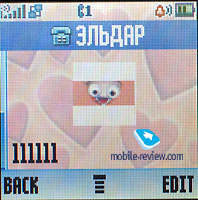
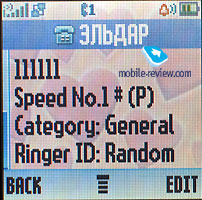
However I have noticed a small disadvantage - when you are deleting an entry from the phone book, you will have to delete each number assigned to it separately. It's impossible to delete them all at once.
Users' names or names with assigned images may be displayed in a general list that is very comfortable. Name sorting is possible in different ways (speed dialing number, name, e-mail address). The phone book reminds the one in Samsung phones (unlimited number of fields per a name, you can enter as much as you wish), on the other hand it has some obvious advantages and additional parameters (personal photo, ring tone). At the moment Motorola is the only manufacturer to offer such kind of a phone book, the others have certain limitations on one of the parameters (one photo for each name, and the lack of ability to bind it to separate numbers, the same goes for the ring tones).
A separate mass message function is present here; a user may edit subscription lists manually.
Messages. The first disappointment is that there is no additional memory for SMS; you can only use SIM-card memory. The company considered that MMS will become the future standard and they decided to head for it. However this phone does support EMS, but there is the very same SIM-card limit.
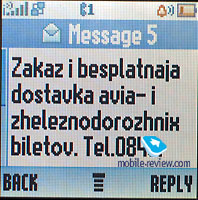 
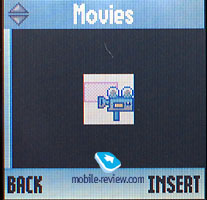 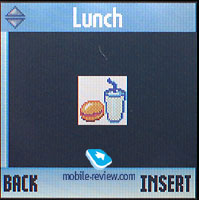
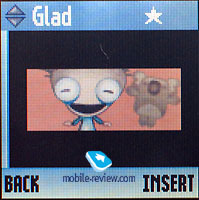 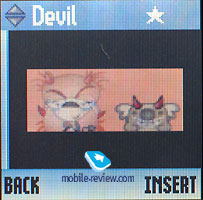
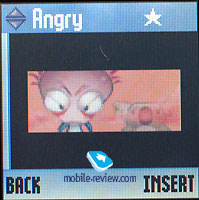
Working with MMS does not bring any inconvenience; everything is simple and understandable. Photos by the integrated camera or sound files may be attached to a message. The ten predefined MMS templates are really great, be sure to check them out
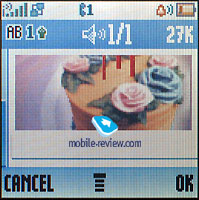 
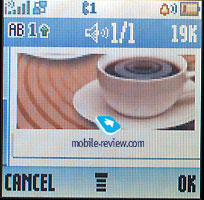
WAP. The phone has a WAP-browser v2.0 and its possibilities are standard, so, nothing special can be said. GPRS (class 10) is present, the settings are rather simple, just follow your operator's instructions and everything will be done in a matter of minutes. In the original phones, intended for the Russian market, there are settings of three basic operators for Moscow and three operators for Saint Petersburg. Having chosen them, you will not need any additional installations.
Office Tools. The whole set of applications is stored here; the simplest of them is a calculator. After you press the Menu button you will get access to the memory functions, as well as the currency converter.

Shortcuts are located in the same menu. You can create shortcuts not only for various menu sections, but for a definite wap-site as well.
Alarm clock. You can create several alarm clocks and choose a custom ring tone, name and volume, type of reoccurrence (daily, once) for each of them. This phone was designed for permanent use, that's why entering names and titles for the alarm clocks is required. This option seemed wicked at first, so I went on naming the alarm clocks with some random letters like A, G, J, R, M etc. I've ended up with a huge mess of alarm clocks, so I was forced to leave only one of them. Everything became clear and useful after sorting up the titles. My final list was the following: morning, weekday, weekend, training, interview for the radio. Of course, it was possible to make the appointments in the organizer, but I do not really like marked squares in the calendar, seeing really important appointments and business that are not suitable for daily "To Do list" separately is much better. The alarm clocks are an ideal solution for these needs; they can be activated by one key press and will warn you about the appointment. You just have to set them up once. Someone can refuse by saying that the Alarm Clocks are rather routine and not really needed since most of the people use them only to get up in the morning. Well, it depends on a person but, as for me, I am really busy and sometimes it happens that I forget some important meetings, so a set of Alarm Clocks will save me theoretically.
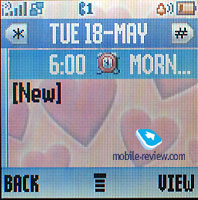 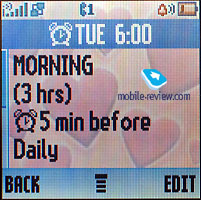

Organizer. You can view it monthly or weekly with a breakdown for hours. You will see your appointments bind to a certain time of the day in the calendar in the stand by mode, it's convenient. Each entry can be provided with a name, start time, length (measured in hours, the minimal amount of time - 30 minutes). Warning can be set in advance. Each entry can be recurrent, this is a significant plus.
 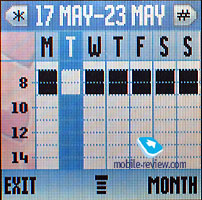
Games and applications. The phone supports Java; all applications that are stored in this section are created using this technology. Depending on the market on which this phone was bought, number of games and their titles will differ. In our sample we had such preinstalled games as Skipping Stones (logical game), and Hungry Fish (you must avoid big fish and eat small ones).
 
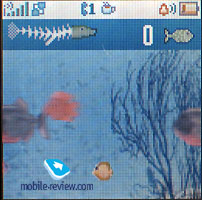
Whenever you are working with Java applications you will notice a proper icon - a coffee cup. There were no problems encountered during upload of new games, the installation went smoothly. The maximal size of Java application was 100 KB, the phone supports MIDP 2.0.
Multimedia. The phone supports themes. It is a set of wallpapers, color schemes for the menu, sounds and ring tone types. You can change the appearance of your phone almost instantly and this is really fun. New themes can be downloaded from Motorola's website.

MotoMixer - original sound file editor that allows mixing tracks. You can play with it from time to time; the results may come out rather unexpected and nice. However, as the practice shows, these sound editors are nothing more than a toy for most of the users.

Sounds - the information about all sound files located in the phone's memory is stored here. You can check out their size, info and even listen to them. The player is similar to other Motorola's phones; everything is clear and easy to understand.

Picutres - list of all images located in the phone's memory. There's a special icon near the file name. Each picture can be set as a wallpaper or a screensaver. Pictures can be sorted in categories; this will make browsing easier. A special editor is present as well, it allows putting frames, changing color scheme and using special effects. The most convenient part is that after mocking the picture it can be stored with a new name. This means that both the original and the new picture will be available for use. This may come handy in case you want to edit a photo, and not to ruin the original.

Settings. Here you can setup all Display settings including color schemes.
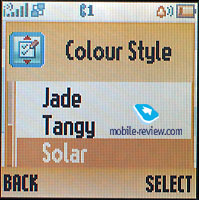 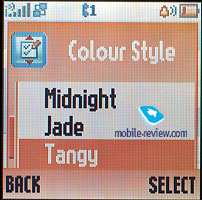
 
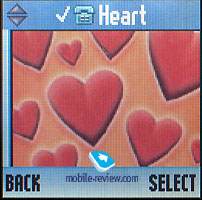 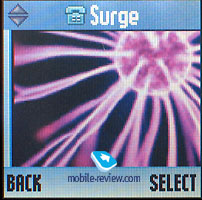

Ring tone type and notification mode (mixed mode, when the vibrating alert works at the same time with the present ring tone) is here as well.
I don't think there is any need to describe the network and security settings since they are all similar to any other phone.
The last thing I wanted to tell you about is the amount of available dynamic memory. On the whole there are about 1,6 MB of memory; about 1.4 MB of it is available primordially. This should be enough for most built-in applications, plus there will be some space left for own pictures and other stuff.
Bluetooth. The device is equipped with bluetooth 1.2 that can be used both for connecting a headset and transmitting data (GPRS-modem mode). It shows no peculiarities or differences from other Motorola's models. A device is seen for 60 seconds and then it should be initialized again. The device can accept files of supported formats. We failed to send pictures via Bluetooth, since found no corresponding menu item. The function can also be used for synchronization with PC.
Graphical sub-system performance
The JBenchmark v2 test was used for testing the graphical sub-system performance. As a result we have gained the following,
which is similar to С380/С650:
Overall score 56
- Work with graphics 43
- Text 184
- Sprites 176
- 3D transformations 5
- User interface 76
On the whole the picture does not look so cloudless, the processor and considerably low amount of memory are affecting
the performance, the phone works with graphics worse than such phones as
Siemens C65 (98 points),
Siemens CХ65 (87 points). For example the worse results in
working with graphics belong to such phones as Siemens ST60,
Sagem myX-7. Let me remind you that Motorola C350 had a pretty weak
processor as well, and it was not going well with the graphics either. It turns out that games are the weakest point of this
phone; in all other applications low graphical performance is not noticeable.
Impressions The network reception quality is well. The volume of 24-tone polyphonic ring tone is loud enough; the phone can be heard even if it is in your pocket. The vibrating alert is average in power and is not always felt. The phone has a good loudspeaker; it can be compared with best products by other manufacturers. Support for mp3 files as a call melody (mono, up to 96 KB flow) is an evident plus. You should record short fragments in order not to run out of memory at once.
 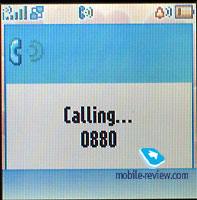
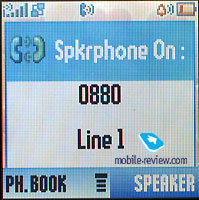
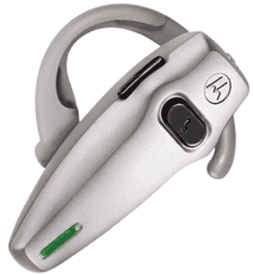
The kit includes HS805 headset powered by a usual finger battery. The headset is rather ascetic in functions and provides only the main possibilities. The success of the combination would have been dubious if the manufacturer had allowed too much liberty with the price, but it promises to be very interesting. The kit that will be sold since the end of June will cost 130-135 USD (however it may cost more at first). And this price is too little for a phone with Bluetooth and a headset in a package. Though, there are some second-hand phones with higher functionality and Bluetooth. The Motorola C390 is interesting as an assortment solution.
Melody samples (400 KB, mp3)
Eldar Murtazin ([email protected])
Translated by Maria Mitina ([email protected])
Published — 29 June 2005
Have something to add?! Write us... [email protected]
|












































